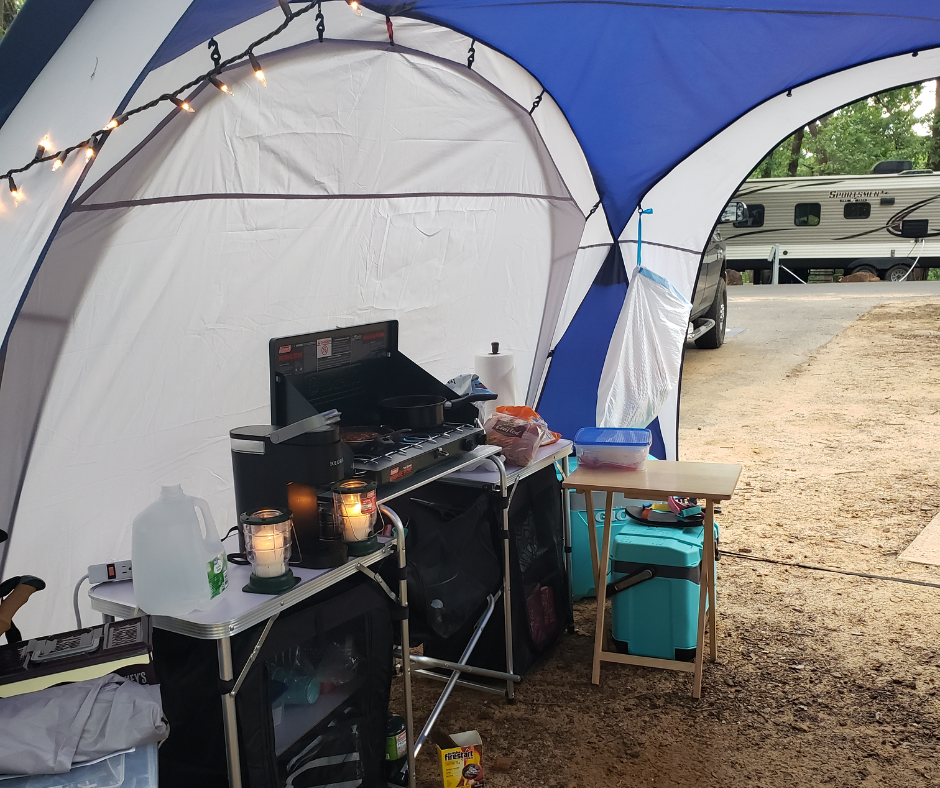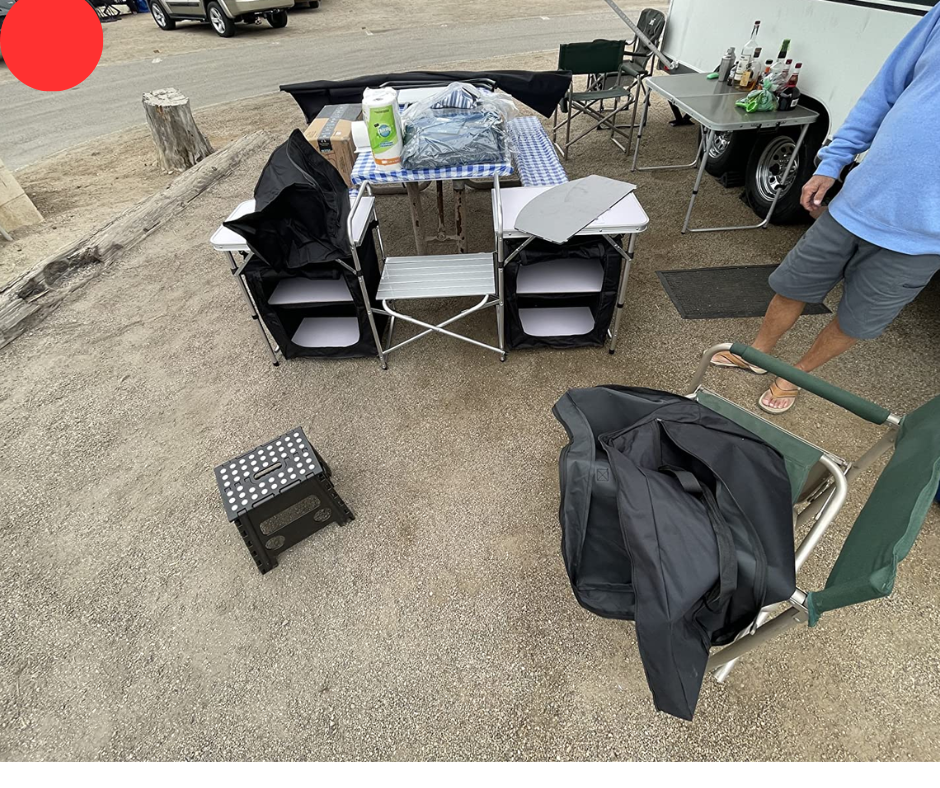Packing a camp kitchen is one of the most important steps in ensuring a stress-free and enjoyable camping trip. A well-organized campsite kitchen setup can make cooking in the great outdoors feel as easy as preparing a meal at home. I’ve learned firsthand that taking the time to pack thoughtfully not only saves you time and hassle but also helps you avoid scrambling for gear when you’re hungry and tired. In this guide, I’ll walk you through how to pack your camp kitchen with the essentials, share a few of my favorite tips, and explain how small adjustments can make a huge difference. Let’s dive in and get your camp kitchen ready for a seamless camping experience!
Why a Good Camp Kitchen Setup Matters
A good camp kitchen setup isn’t just about having the right tools—it’s about setting the stage for a stress-free, enjoyable trip. Think of your kitchen as the heart of your campsite. It’s where you’ll fuel your body after a long hike, prepare meals that bring everyone together, and—let’s be honest—it’s often where the magic of the trip happens. But without a proper setup, even the most scenic location can feel like a battlefield when you’re trying to cook on a small camp stove with half your gear scattered around.
The key to a successful camping trip is organization. When your kitchen is well-organized, you can move around the campsite with ease, cooking up meals quickly without rummaging through bags or wasting time. The goal is to minimize stress and maximize enjoyment. Whether it’s a gourmet meal or simple grilled hot dogs, having everything in its place means you can focus on the experience instead of running around looking for your spatula.
Let me tell you about a trip where the kitchen setup was everything. A few years ago, I went camping with a group of friends. On the first night, we had the worst time trying to cook a simple meal. One person forgot the matches, another lost the knife, and we spent half an hour trying to figure out how to set up a wobbly camp table. It was stressful, frustrating, and, honestly, it almost ruined the vibe of the trip. But on our next trip, we learned from that disaster and put together a solid kitchen setup. We made sure everything had a designated spot, and by the end of the weekend, we were cooking meals with ease and having a blast. That experience really taught me how much a good kitchen setup can make or break a trip.
Key Items for Your Camping Kitchen Setup
When you’re out in the wild, cooking should feel like an enjoyable experience, not a frustrating chore. But to make that happen, you need to have the right gear packed and ready to go. Think of your camping kitchen as a well-oiled machine—every tool and utensil plays a part in making the process smoother and more efficient.
Cooking Gear: Pots, Pans, and Utensils
At the heart of your camp kitchen are your cooking tools. A good pot and pan set is essential because, let’s face it, nothing beats a hearty meal after a long day of hiking. I’ve found that having a set that nests together saves space and keeps things neat. And don’t forget a sturdy spatula, tongs, and a couple of sharp knives. Trust me, the difference between a dull knife and a sharp one when you’re slicing veggies or grilling meat is night and day.
Portable Stove or Grill
A portable stove or grill is a must-have. I’ve used both, and each has its perks. The stove is quick, easy to set up, and great for boiling water or frying up a meal. A portable grill, on the other hand, gives you that authentic campfire cooking experience and adds a delicious smoky flavor to everything you cook. Just make sure to bring enough fuel to keep things running smoothly, and always check your stove’s setup before heading out.
Fuel and Fire-Starting Equipment
Speaking of fuel, don’t forget this crucial item. Running out of fuel halfway through cooking can really put a damper on things. I’ve learned the hard way to pack extra fuel, as well as fire-starting equipment—lighters, matches, or even a flint. You don’t want to be struggling to start a fire when the sun is setting, and everyone’s hungry.

Cooking Essentials: Cutting Boards, Knives, and Can Openers
Now, let’s talk about the little things that make a huge difference. A good cutting board is a camping game-changer—it provides a clean, sturdy surface to prep your food. I always pack a couple of different sizes because sometimes you’re chopping veggies, other times, you might need a larger surface for meat. Don’t skimp on a reliable knife either—it should feel good in your hand and be able to handle whatever you throw at it. Oh, and can openers? You might think you can get by without one, but trust me, they’re a lifesaver for opening canned goods in a flash.
Clean-Up Essentials: Sponges, Dish Soap, and Trash Bags
When the meal’s over and it’s time to clean up, the last thing you want is to be digging through bags trying to find your soap or sponges. Having a dedicated clean-up kit ready to go makes life so much easier. I always pack biodegradable soap, a reusable sponge, and enough trash bags to properly dispose of everything. Keeping your campsite tidy isn’t just about aesthetics—it’s about safety too, especially if you’re in bear country. Nothing attracts wildlife more than a messy kitchen, so I always keep my trash in a sealed bag and clean everything thoroughly.
Camping Cooking Essentials
At the end of the day, camping cooking essentials are about packing just enough to make your meals enjoyable without overloading your pack. Keep it simple—only bring what you truly need, but make sure each item serves its purpose. I’ve found that a little forethought in packing can save you hours of frustration and ensure that when it’s time to cook, you’re ready for whatever adventure the day holds.
By organizing your gear and selecting the right tools, you’ll have a smoother, more enjoyable time cooking at camp. These simple but essential items will keep your camp kitchen running like a pro, so you can focus on what really matters: enjoying your time outdoors.
Camp Kitchen Setup Ideas: How to Organize Your Gear
Maximize Space with Smart Packing Techniques
Packing efficiently is one of the key secrets to making your camp kitchen work seamlessly. The last thing you want is to show up at the campsite only to realize you can’t find that essential pot or your favorite spatula. That’s where smart packing comes in. By nesting items—like pots, pans, and bowls—you’ll save a ton of space. I always make sure my cooking gear fits together like a puzzle; it’s a game-changer when space is tight.
Another tip is using multi-functional tools. For example, a spatula that doubles as a bottle opener or a knife with a built-in can opener can save you from carrying extra gear. One trip, I packed a small folding cutting board that doubled as a prep station and a tray for holding hot items off the ground. Little things like this can make a big difference and keep your packing light and efficient.
Setting Up Your Camp Kitchen at the Campsite
Now that you’ve packed your kitchen gear with military precision, it’s time to set up camp. Finding the right spot for your kitchen is just as important as the gear itself. Trust me, it’s not just about convenience—it’s about creating a functional and safe space to cook. The key is to find a flat, stable surface that will keep everything from sliding around while you’re cooking. I’ve learned the hard way that a wobbly table can make even the simplest task, like flipping pancakes, feel like an Olympic sport.
Location is another factor. You’ll want to set up near water for easy access to cleaning up and cooking, but make sure it’s far enough from your tents and sleeping areas to avoid attracting wildlife. One time, we set up our kitchen too close to our tent, and a curious raccoon decided to join us for dinner. Let’s just say, it wasn’t the most peaceful meal!
A pro tip: If you’re camping in a group, set up the kitchen in a spot that’s easy for everyone to gather around. This encourages bonding and makes cleanup easier when everyone pitches in.
Packing a Complete Camp Kitchen List
Now that you’ve got the basics of what makes a good camp kitchen setup, let’s dive into the nitty-gritty of packing. Whether you’re a seasoned camper or a newbie, a well-thought-out kitchen list can save you a lot of stress and wasted time. From the essential gear to extra items that can elevate your camping meals, I’ve gathered everything I’ve learned over the years. Let’s take a closer look at what you’ll need.

Cooking Gear
First and foremost, cooking gear is the backbone of your camp kitchen. You can’t cook without it, right? Here’s a list of the essentials:
- Stove or Portable Grill: Whether you go for a compact camp stove or a classic portable grill, having a reliable cooking source is key. I’ve tried both, and while the stove is convenient and compact, the grill gives your meals that smoky, fire-kissed flavor that just hits differently when you’re camping. Both need a good supply of fuel, so pack extra just in case.
- Pots, Pans, and Utensils: A sturdy pot and a pan that stack together are lifesavers when space is tight. You’ll want at least one pot for boiling water or making stews, and one pan for frying up eggs, bacon, or pancakes. As for utensils, don’t skimp on a spatula, tongs, and sharp knives. A dull knife can turn meal prep into a mini disaster.
- Cutting Boards and Can Openers: You’ll need something sturdy to chop your veggies and meat. I recommend a lightweight, foldable cutting board. Can openers are easy to forget, but trust me, you’ll want one, especially if you’re relying on canned goods.
I learned this the hard way during a trip when I forgot the can opener, and we had to struggle with a pair of blunt scissors to get into our beans. Not fun!
Food Storage
Keeping your food fresh is just as important as cooking it right. Here’s what I recommend for food storage:
- Coolers: A good cooler will keep your perishables fresh for days. I prefer the ones with separate compartments so you can organize meats, veggies, and dairy. Be sure to pack plenty of ice or ice packs to keep everything cool, especially if you’re camping in warmer weather.
- Food Containers and Bags: Bring airtight food containers to store leftovers or pre-made meals. Zip-lock bags are also handy for organizing dry goods like spices, grains, and snacks. One trick I learned is to bring a few vacuum-sealed bags for items like cheese or deli meats—this keeps everything fresher for longer.
You don’t want to risk your favorite camping meal going bad because you didn’t pack your food properly. I had a trip where I was excited for a fresh salad, only to realize my lettuce wilted before the first night was over. Lesson learned: airtight containers are key.
Cleaning and Waste Disposal
Keeping your camp kitchen clean is just as crucial as cooking a delicious meal. Here’s what you’ll need for waste disposal and cleaning:
- Biodegradable Soap and Reusable Cloths: You’re outdoors, so it’s important to respect nature. I always pack biodegradable soap for dishwashing. Reusable cloths or sponges are perfect for wiping down surfaces, and they take up less space than paper towels.
- Trash Bags: Pack a couple of large trash bags for collecting food waste and any other trash. I use sealable bags to prevent wildlife from getting into the trash. In bear country, this is especially crucial.
A good cleaning setup makes a world of difference. I’ve camped in areas where the trash piles up quickly, and having a designated system helps keep the area tidy and safe. Not to mention, it prevents you from scrambling for cleaning supplies once you’re done cooking.
Extras to Enhance Your Cooking Experience
Sometimes, it’s the little extras that make your camp kitchen feel like home. While these items aren’t strictly necessary, they can definitely enhance your camping experience:
- Campfire Grill: If you want that authentic, smoky flavor, a small campfire grill is a must-have. I love cooking sausages and veggies on the grill. It’s just something about the flames and the aroma that makes it all feel more rustic and fun.
- Portable Sink or Wash Station: If you have the space and setup for it, a portable sink can be a game-changer. It makes washing dishes and hands way easier, and you won’t have to lug everything to a water source.
- Kitchen Shelter: If you’re camping in unpredictable weather, a kitchen shelter or tarp can protect your gear and your cooking area from rain or wind. This makes a huge difference, especially if you’re caught in a downpour while trying to flip pancakes.
On one trip, we didn’t pack a shelter, and cooking in the rain was miserable. We were soaked, the gear was wet, and everything just felt off. A kitchen shelter would’ve saved us from that hassle.
Packing a well-thought-out camp kitchen can take your trip from chaotic to calm. When you’re out in the wilderness, there’s nothing better than knowing exactly where everything is and having the right tools at hand. Whether you’re making a gourmet campfire stew or simply roasting marshmallows, the right gear makes all the difference.
A little preparation goes a long way, and I promise, once you get your camp kitchen set up just right, cooking in the wild will be one of the highlights of your trip.
FAQs: Common Questions About Packing a Camp Kitchen
What are the most essential items for a camping kitchen?
When packing a camp kitchen, there are a few must-haves to make sure your cooking experience goes smoothly. First, a stove or portable grill is crucial to heat up meals. Along with that, you’ll need basic cooking gear like a pot, pan, sharp knives, and utensils such as a spatula and tongs. Don’t forget a cutting board and a reliable can opener. Clean-up essentials are also important, so pack biodegradable soap, sponges, and plenty of trash bags. Trust me, these basics will save you more than a few headaches on your trip.
Can I use my regular kitchen equipment for camping?
Technically, you can use your regular kitchen gear, but it’s not always the best idea. Regular kitchen equipment might be too bulky, too fragile, or simply not designed for the outdoors. For example, using your favorite kitchen knife might work, but if it gets damaged on a rough camping trip, it’s hard to replace. Plus, packing bulky items like large pots or glass containers can take up precious space. I recommend using compact, durable camping versions of your kitchen gear. They’re made for the job and will save space while being tough enough to handle the great outdoors.
How do I pack cooking tools without taking up too much space?
When it comes to space, packing smart is key. One of the best tricks is nesting your items—pots and pans that fit inside one another are a game-changer. A set of stacking bowls or collapsible measuring cups can also save you a ton of room. For utensils, try using multi-functional tools like a spatula that doubles as a bottle opener or a knife with a built-in can opener. It’s amazing how much space you can save when you think about functionality as well as practicality. And trust me, once you start packing this way, you’ll wonder how you ever camped without it.
What are some must-have items for a campsite kitchen setup?
Aside from the obvious cooking gear, there are a few extras that can make a world of difference. A good cooler to keep food fresh is a must—I’ve learned that the hard way. Also, consider a portable sink or wash station if you have space. It’s a real luxury for keeping dishes clean and making sure your hands stay sanitized. Another handy item is a campfire grill—nothing beats cooking over an open flame for that authentic outdoor flavor. Lastly, a kitchen shelter or tarp can save you from getting caught in the rain while trying to cook.
How do I clean up my camp kitchen efficiently?
Clean-up after a camping meal doesn’t have to be a nightmare. The key is to be organized from the start. Make sure to bring biodegradable soap and a sponge or reusable cloths that you can use to clean everything up. I also recommend packing a couple of trash bags—one for recyclables and another for food waste. A great tip is to keep a sealed trash bag to store food scraps, especially if you’re camping in bear country. Staying on top of your clean-up will keep your campsite safe and tidy, and it’s always nice not to have to spend hours looking for a clean pot or fork the next day.
Conclusion
A well-packed and organized camp kitchen is the key to a stress-free and enjoyable camping experience. By planning, choosing the right gear, and keeping your setup tidy, you can focus on what matters—enjoying the great outdoors. Happy camping!

I’m a writer and culinary expert with over 10 years of experience in the kitchen. As a graduate of the Institute of Culinary Education and a passionate home chef, I created KitchenBreez.com to share my knowledge of kitchen techniques, cooking tips, and the best kitchen gadgets. Whether you’re a seasoned cook or just starting, my goal is to help you make your time in the kitchen more efficient and enjoyable.
